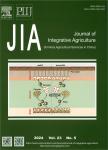Assessment of the crucial factors influencing the responses of ammonia and nitrous oxide emissions to controlled release nitrogen fertilizer: A meta-analysis
作者机构:State Key Laboratory of Efficient Utilization of Arid and Semi-arid Arable Land in Northern China/Key Laboratory of Plant Nutrition and FertilizerMinistry of Agriculture and Rural Affairs/Institute of Agricultural Resources and Regional PlanningChinese Academy of Agricultural SciencesBeijing 100081P.R.China
出 版 物:《Journal of Integrative Agriculture》 (农业科学学报(英文版))
年 卷 期:2023年第22卷第11期
页 面:3549-3559页
核心收录:
学科分类:090101[农学-作物栽培学与耕作学] 09[农学] 0901[农学-作物学]
基 金:financially supported by the Smart Fertilization Project (05) the National Key Research & Development Program of China (2022YFD1700605)
主 题:controlled release urea NH volatilization N O emission environmental factor management practice
摘 要:Reducing ammonia(NH3) and nitrous oxide(N2O) emissions have great effects on mitigating nitrogen(N) nutrient loss and greenhouse gas emissions. Controlled release urea(CRU) can control the N release rate, which reduces reactive N loss and increases nitrogen use efficiency relative to conventional urea(CU). However, the crucial factors influencing the responses of NH3and N2O emissions to CRU relative to CU are still unclear. In this study, we evaluated the responses of NH3and N2O emissions to CRU based on collected field data with a meta-analysis. CRU reduced the NH3and N2O emissions by 32.7 and 25.0% compared with CU, respectively. According to subgroup analysis, CRU presented better mitigation of NH3and N2O emissions in soils with pH 6.5–7.5(–47.9 and –23.7%) relative to either pH7.5(–29.3 and –17.3%), and in the rice season(–34.8 and –29.1%) relative to the wheat season(–19.8 and –22.8%). The responses of NH3and N2O emissions to CRU increased from rainfed(–30.5 and –17.0%) to irrigated(–32.5 and –22.9%), and then to paddy(–34.8 and –29.1%) systems. In addition, the response of N2O emission mitigation increased with increases in soil total nitrogen(TN);however, soil TN did not significantly affect the response of NH3volatilization. The reduction in NH3emission was greater in sandy-textured soil(–57.7%) relative to loam-textured(–32.9%) and clay-textured(–32.3%) soils, whereas soil texture did not affect N2O emission. Overall, CRU was a good option for reducing the NH3and N2O emissions relative to CU in agricultural production. This analysis improves our understanding of the crucial environmental and management factors influencing the mitigation of NH3and N2O emissions under CRU application, and these site-specific factors should be considered when applying CRU to reduce reactive N loss and increase NUE.



